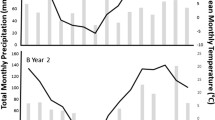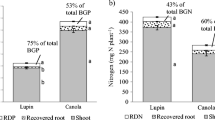Abstract
Belowground N comprises an important component of total residue N, but the N from this pool is often not included in studies that use 15N approaches to trace residue-derived N in succeeding crops. The objective of this greenhouse study was to differentiate between N supplied from aboveground and belowground crop residues, including rhizodeposits, of pea and canola to wheat using 15N labeling. A cross 15N-labeling approach was used in which wheat was grown on 15N-labeled belowground residues and non-labeled aboveground residues and vice versa. On average, the amount of N in wheat derived from belowground residues was almost twice the amount from aboveground residues. The higher input of both aboveground and belowground residue biomass and hence residue N from canola compared to pea tended to increase the residue-derived N in wheat from canola (6.4 %) relative to pea (4.7 %). However, differences in the percent recovery of 15N based on the amount of residue-15N initially applied revealed that a higher proportion of belowground residue N from pea (13.4 %) was recovered in wheat compared to the corresponding aboveground residue N from pea (8.8 %), and both belowground and aboveground residue N from canola (6.5 and 7.3 %, respectively). The total supply of N to wheat from preceding pea and canola crops was relatively low, likely due to wide C/N ratios. This study demonstrates the importance of belowground residue N to the supply of N to succeeding crops as well as differences between species.



Similar content being viewed by others
Abbreviations
- AG:
-
Aboveground
- BG:
-
Belowground
- %Ndfr:
-
Percentage nitrogen derived from residues
References
Abiven S, Recous S, Reyes V, Oliver R (2005) Mineralisation of C and N from root, stem and leaf residues in soil and role of their biochemical quality. Biol Fertil Soils 42:119–128
Arcand MM, Knight JD, Farrell RE (2013) Estimating belowground nitrogen inputs of pea and canola and their contribution to soil inorganic N pools using 15N labeling. Plant Soil 371:67–80
Ayers KW, Acton DF, Ellis JG (1985) The soils of the Swift Current map area 72 J Saskatchewan. Saskatchewan Institute of Pedology, Publ. 86. Extension Division, University of Saskatchewan, Saskatoon, SK. Extension Publ. 48
Beckie HJ, Brandt SA, Schoenau JJ, Campbell CA, Henry JL, Janzen HH (1997) Nitrogen contribution of field pea in annual cropping systems. 2. Total nitrogen benefit. Can J Plant Sci 77:323–331
Bremer E, van Kessel C (1992a) Plant-available nitrogen from lentil and wheat residues during a subsequent growing season. Soil Sci Soc Am J 56:1155–1160
Bremer E, van Kessel C (1992b) Seasonal microbial biomass dynamics after addition of lentil and wheat residues. Soil Sci Soc Am J 56:1141–1146
Bremer E, Janzen HH, Ellert BH, McKenzie RH (2011) Carbon, nitrogen, and greenhouse gas balances in an 18-year cropping system study on the Northern Great Plains. Soil Sci Soc Am J 75:1493–1502
Delgado J, Del Grosso S, Ogle S (2010) 15N isotopic crop residue cycling studies and modeling suggest that IPCC methodologies to assess residue contributions to N2O-N emissions should be reevaluated. Nutr Cycl Agroecosyst 86:383–390
Gan YT, Miller PR, McConkey BG, Zentner RP, Stevenson FC, McDonald CL (2003) Influence of diverse cropping sequences on durum wheat yield and protein in the semiarid Northern Great Plains. Agron J 95:245–252
Gan YT, Campbell CA, Janzen HH, Lemke RL, Basnyat P, McDonald CL (2009) Carbon input to soil from oilseed and pulse crops on the Canadian prairies. Agric Ecosyst Environ 132:290–297
Handayanto E, Cadisch G, Giller KE (1997) Regulating N mineralization from plant residues by manipulation of quality. In: Cadisch G, Giller KE (eds) Driven by nature: plant litter quality and decomposition. CAB International, Wallingford, pp 175–185
Hauck RD, Bremner JM (1976) Use of tracers for soil and fertilizer nitrogen research. Adv Agron 28:219–266
Hood RC, N’Goran K, Aigner M, Hardarson G (1999) A comparison of direct and indirect 15N isotope techniques for estimating crop N uptake from organic residues. Plant Soil 208:259–270
Jensen ES (1994) Availability of nitrogen in 15N-labelled mature pea residues to subsequent crops in the field. Soil Biol Biochem 26:465–472
Jensen ES (1996) Nitrogen immobilization and mineralization during initial decomposition of 15N-labelled pea and barley residues. Biol Fertil Soils 24:39–44
Jensen LS, Mueller T, Magid J, Nielsen NE (1997) Temporal variation of C and N mineralization, microbial biomass and extractable organic pools in soil after oilseed rape straw incorporation in the field. Soil Biol Biochem 29:1043–1055
Khan WDF, Peoples MB, Herridge DF (2002) Quantifying below-ground nitrogen of legumes. 1. Optimising procedures for 15N shoot-labelling. Plant Soil 245:327–334
Lam S, Chen D, Norton R, Armstrong R (2013) The effect of elevated atmospheric carbon dioxide concentration on the contribution of residual legume and fertilizer nitrogen to a subsequent wheat crop. Plant Soil 364:81–91
Lupwayi NZ, Kennedy AC (2007) Grain legumes in Northern Great Plains: impacts on selected biological soil processes. Agron J 99:1700–1709
Lupwayi NZ, Clayton GW, O’Donovan JT, Harker KN, Turkington TK, Soon YK (2006) Nitrogen release during decomposition of crop residues under conventional and zero tillage. Can J Soil Sci 86:11–19
May WE, Brandt SA, Gan Y, Kutcher HR, Holzapfel CB, Lafond GP (2010) Adaptation of oilseed crops across Saskatchewan. Can J Plant Sci 90:667–677
Mayer J, Buegger F, Jensen ES, Schloter M, Heβ J (2003a) Estimating N rhizodeposition of grain legumes using a 15N in situ stem labelling method. Soil Biol Biochem 35:21–28
Mayer J, Buegger F, Jensen ES, Schloter M, Heβ J (2003b) Residual nitrogen contribution from grain legumes to succeeding wheat and rape and related microbial process. Plant Soil 255:541–554
Mayer J, Buegger F, Jensen ES, Schloter M, Heβ J (2004) Turnover of grain legume N rhizodeposits and effect of rhizodeposition on the turnover of crop residues. Biol Fertil Soils 39:153–164
McGonigle TP, Hutton M, Greenley A, Karamanos R (2011) Role of mycorrhiza in a wheat-flax versus canola-flax rotation: a case study. Commun Soil Sci Plant Anal 42:2134–2142
McNeill AM, Fillery IRP (2008) Field measurement of lupin belowground nitrogen accumulation and recovery in the subsequent cereal-soil system in a semi-arid Mediterranean-type climate. Plant Soil 302:297–316
McNeill AM, Zhu C, Fillery IRP (1998) A new approach to quantifying the N benefit from pasture legumes to succeeding wheat. Aust J Agric Res 49:427–436
Nannipieri P, Paul E (2009) The chemical and functional characterization of soil N and its biotic components. Soil Biol Biochem 41:2357–2369
Nicolardot B, Recous S, Mary B (2001) Simulation of C and N mineralisation during crop residue decomposition: A simple dynamic model based on the C:N ratio of the residues. Plant Soil 228:83–103
Russell CA, Fillery IRP (1996a) In situ 15N labelling of lupin below-ground biomass. Aust J Agric Res 47:1035–1046
Russell C, Fillery IRP (1996b) Estimates of lupin below-ground biomass nitrogen, dry matter, and nitrogen turnover to wheat. Aust J Agric Res 47:1047–1059
Sangster A, Knight D, Farrell R, Bedard-Haughn A (2010) Repeat-pulse 13CO2 labeling of canola and field pea: implications for soil organic matter studies. Rapid Commun Mass Spectrom 24:2791–2798
Senaratne R, Hardarson G (1988) Estimation of residual N effect of faba bean and pea on two succeeding cereals using 15N methodology. Plant Soil 110:81–89
Soon YS, Arshad MA (2002) Comparison of the decomposition and N and P mineralization of canola, pea and wheat residues. Biol Fertil Soils 36:10–17
Stevenson FC, van Kessel C (1996a) A landscape-scale assessment of the nitrogen and non-nitrogen rotation benefits of pea. Soil Sci Soc Am J 60:1797–1805
Stevenson FC, van Kessel C (1996b) The nitrogen and non-nitrogen rotation benefits of pea to succeeding crops. Can J Plant Sci 76:735–745
Stevenson FC, Walley FL, van Kessel C (1998) Direct vs. indirect nitrogen-15 approaches to estimate nitrogen contributions from crop residues. Soil Sci Soc Am J 62:1327–1334
Trinsoutrot I, Recous S, Mary B, Nicolardot B (2000) C and N fluxes of decomposing 13C and 15N Brassica napus L.: effects of residue composition and N content. Soil Biol Biochem 32:1717–1730
Acknowledgments
Financial support was provided by Agriculture and Agri-Food Canada, the Saskatchewan Pulse Growers, the Saskatchewan Ministry of Agriculture Strategic Research Program—Soil Biological Processes, and the Natural Sciences and Engineering Research Council of Canada. We are grateful to M. Stocki for the stable isotope analysis and to A. Krikau and J. Hnatowich for technical assistance.
Author information
Authors and Affiliations
Corresponding author
Rights and permissions
About this article
Cite this article
Arcand, M.M., Knight, J.D. & Farrell, R.E. Differentiating between the supply of N to wheat from above and belowground residues of preceding crops of pea and canola. Biol Fertil Soils 50, 563–570 (2014). https://doi.org/10.1007/s00374-013-0877-4
Received:
Revised:
Accepted:
Published:
Issue Date:
DOI: https://doi.org/10.1007/s00374-013-0877-4




